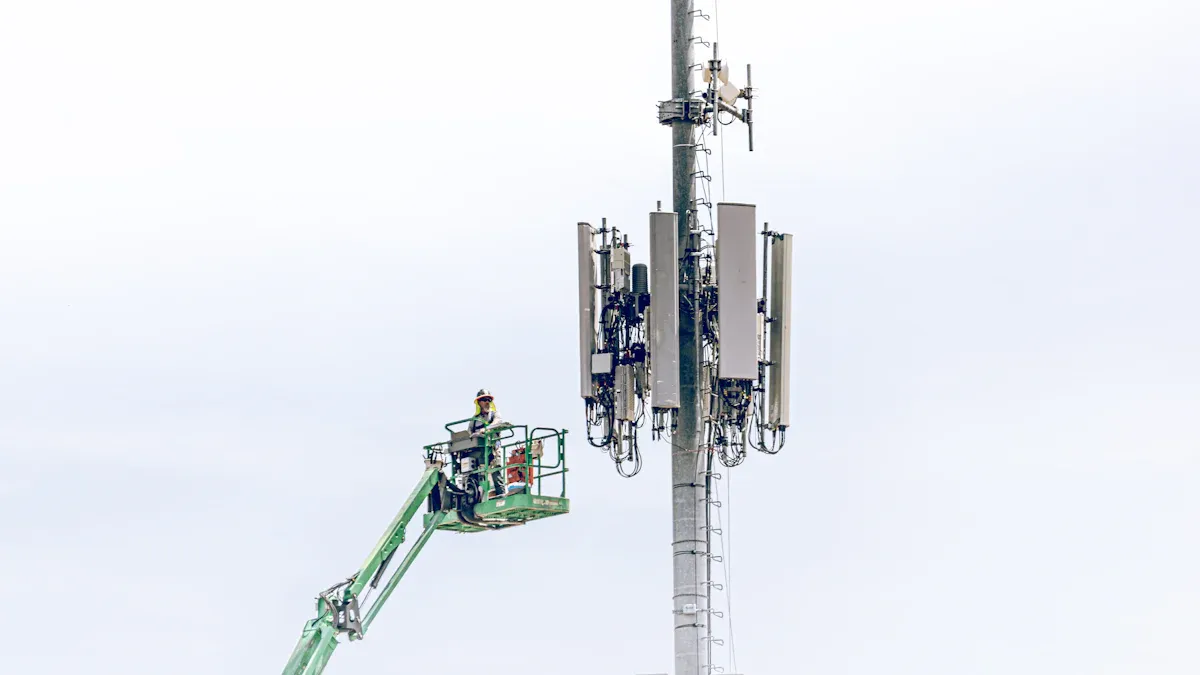
Maintaining an explosion proof telephone is essential for ensuring safety in hazardous environments. Regular care minimizes the risk of malfunctions and keeps the device functioning effectively. For an IP explosion proof telephone, proper upkeep also ensures compliance with safety standards. Neglecting maintenance can compromise an emergency explosion proof telephone’s reliability during critical moments.
Key Takeaways
- Clean your explosion-proof phone often with approved cleaners. Do not use strong chemicals to keep it working well.
- Check your phone every month for damage and broken seals. Finding problems early stops bigger issues later.
- Keep your phone in a dry, safe spot, away from heat or cold. Follow the maker’s rules to keep it explosion-proof.
Cleaning and Care for Explosion Proof Telephones

Keeping your explosion proof telephone clean is essential for maintaining its functionality and safety. Proper cleaning prevents dirt and debris from interfering with the device’s performance. Follow these steps to ensure your telephone remains in excellent condition.
Use Manufacturer-Approved Cleaning Agents
Always use cleaning agents recommended by the manufacturer. These products are specifically designed to clean your explosion proof telephone without causing damage. Check the user manual or contact the manufacturer to find the approved cleaning solutions. Using the wrong products can harm the device’s protective features, reducing its ability to function safely in hazardous environments.
Tip: Test the cleaning agent on a small, inconspicuous area of the telephone before applying it to the entire surface. This ensures compatibility and prevents accidental damage.
Avoid Harsh Chemicals and Abrasives
Harsh chemicals, such as bleach or ammonia, can corrode the surface of your explosion proof telephone. Abrasive materials, like steel wool or rough sponges, may scratch the device, compromising its protective coating. Instead, use a soft cloth or sponge to clean the surface gently. This approach preserves the integrity of the device and ensures it continues to meet safety standards.
Note: Even minor scratches can weaken the explosion-proof features of the telephone. Handle the device with care during cleaning.
Clean Vents and Openings to Prevent Blockages
Dust and debris can accumulate in the vents and openings of your explosion proof telephone. Blockages may affect the device’s performance or cause overheating. Use a soft brush or compressed air to remove dirt from these areas. Regularly cleaning the vents ensures proper airflow and prevents potential malfunctions.
Reminder: Avoid using water or liquid cleaners near the vents and openings. Moisture can damage the internal components of the telephone.
By following these cleaning and care tips, you can keep your explosion proof telephone in optimal condition. Regular maintenance not only extends the device’s lifespan but also ensures it remains reliable in critical situations.
Regular Inspection of Explosion Proof Telephones
Regular inspections are essential to keep your explosion proof telephone in top condition. These checks help you identify potential issues before they become serious problems. By inspecting the device regularly, you can ensure it remains safe and reliable in hazardous environments.
Check for Physical Damage or Wear
Start by examining the exterior of your explosion proof telephone. Look for cracks, dents, or other visible signs of damage. Pay close attention to areas that experience frequent use, such as the handset, keypad, and mounting points. Physical wear can weaken the device and compromise its safety features. If you notice any damage, address it immediately to prevent further issues.
Tip: Use a flashlight to inspect hard-to-see areas. This helps you spot hidden damage that might otherwise go unnoticed.
Inspect Seals and Gaskets for Integrity
Seals and gaskets play a critical role in maintaining the explosion-proof properties of your telephone. These components prevent hazardous substances, such as dust or gas, from entering the device. Check the seals and gaskets for cracks, tears, or signs of wear. Even minor damage can reduce their effectiveness. Replace any compromised seals or gaskets to maintain the device’s safety.
Reminder: Always use manufacturer-approved replacement parts to ensure compatibility and reliability.
Look for Corrosion or Environmental Damage
Hazardous environments often expose your explosion proof telephone to moisture, chemicals, and extreme temperatures. Over time, these factors can cause corrosion or other environmental damage. Inspect the device for rust, discoloration, or residue buildup. Focus on metal components and connection points, as these are most vulnerable to corrosion. Cleaning and addressing damage promptly can prevent further deterioration.
Alert: Corrosion can spread quickly if left unchecked. Regular inspections help you catch and resolve issues early.
By performing these inspections, you can keep your explosion proof telephone functioning safely and effectively. Regular checks not only protect the device but also ensure it remains compliant with safety standards.
Functional Testing of Explosion Proof Telephones

Functional testing ensures your explosion proof telephone operates effectively in hazardous environments. Regular testing helps you identify performance issues and maintain the device’s reliability.
Test Audio and Signal Quality
Start by checking the audio quality of your telephone. Make a test call to confirm that the sound is clear and free of distortion. Ensure the microphone and speaker work properly. Poor audio quality can hinder communication during emergencies. Next, test the signal strength. Weak signals may indicate issues with the device or its connection to the communication network. Address these problems promptly to avoid disruptions.
Tip: Perform these tests in the actual environment where the telephone is installed. This ensures accurate results.
Verify Explosion-Proof Features
Explosion-proof features are critical for safety. Inspect the device’s casing to ensure it remains intact and undamaged. Test the protective mechanisms designed to prevent sparks or heat from escaping the telephone. These features must function correctly to maintain safety in hazardous areas. If you notice any issues, consult the manufacturer or a professional technician for repairs.
Reminder: Never attempt to modify or repair explosion-proof components yourself. This could compromise the device’s safety.
Conduct Routine System Diagnostics
Run system diagnostics to check the internal components of your telephone. Many explosion proof telephones come with built-in diagnostic tools. Use these tools to identify software or hardware issues. Regular diagnostics help you detect problems early, reducing the risk of unexpected failures.
Alert: Schedule diagnostics at regular intervals to ensure consistent performance.
By performing these functional tests, you can keep your explosion proof telephone reliable and safe for use in critical situations.
Proper Storage Practices for Explosion Proof Telephones
Proper storage is essential to maintain the safety and functionality of your explosion proof telephone. Following these practices ensures the device remains in optimal condition when not in use.
Store in a Safe, Dry, and Secure Location
Always store your telephone in a location that is free from moisture and potential hazards. A dry environment prevents damage caused by humidity or water exposure. Choose a secure area to protect the device from accidental impacts or unauthorized access. If possible, use a dedicated storage cabinet or container designed for sensitive equipment.
Tip: Label the storage area clearly to avoid confusion and ensure the telephone is easily accessible during emergencies.
Protect from Extreme Temperatures
Extreme temperatures can harm the internal components of your telephone. Avoid storing the device in areas exposed to direct sunlight, freezing conditions, or heat sources like radiators. Sudden temperature changes may also cause condensation, leading to potential damage. Maintain a stable temperature range as recommended by the manufacturer.
Reminder: Use a thermometer or temperature monitor in the storage area to ensure consistent conditions.
Follow Manufacturer Storage Guidelines
Refer to the user manual for specific storage instructions provided by the manufacturer. These guidelines are tailored to the design and materials of your telephone. They may include recommendations on humidity levels, positioning, or protective coverings. Adhering to these instructions helps preserve the explosion-proof features of the device.
Alert: Ignoring manufacturer guidelines may void the warranty or compromise the safety of the telephone.
By implementing these storage practices, you can extend the lifespan of your explosion proof telephone and ensure it remains reliable when needed.
Documentation and Compliance for Explosion Proof Telephones
Proper documentation and compliance practices are essential for ensuring the safety and reliability of your explosion proof telephone. These steps help you stay organized and meet industry requirements.
Maintain Detailed Maintenance Logs
Keep a detailed record of all maintenance activities. Document every cleaning, inspection, and repair. Include dates, actions taken, and any parts replaced. This log provides a clear history of the device’s upkeep. It also helps you track recurring issues and identify patterns. Organized records make it easier to demonstrate compliance during audits or inspections.
Tip: Use digital tools or apps to maintain logs. They simplify record-keeping and allow for easy updates.
Adhere to Industry Standards and Regulations
Follow all relevant industry standards and regulations for explosion proof telephones. These guidelines ensure the device operates safely in hazardous environments. Research the specific requirements for your industry and location. Regularly review updates to stay informed about changes. Compliance not only protects your workplace but also avoids penalties or legal issues.
Reminder: Consult the manufacturer’s manual for specific compliance details related to your telephone model.
Schedule Professional Inspections Regularly
Arrange for professional inspections at regular intervals. Certified technicians can identify issues that may not be visible during routine checks. They also verify that the device meets safety standards. Professional inspections provide an extra layer of assurance, ensuring your explosion proof telephone remains reliable.
Alert: Schedule inspections based on the manufacturer’s recommendations or industry guidelines.
By maintaining logs, adhering to standards, and scheduling inspections, you ensure your explosion proof telephone remains safe and compliant.
Maintaining your explosion proof telephone is vital for safety and reliability. Regular cleaning, inspections, and testing ensure it performs well in hazardous environments. Proper storage further extends its lifespan. Consistent maintenance keeps your workplace compliant and reduces risks. Make these steps part of your routine to protect both your equipment and your team.
FAQ
What should you do if your explosion proof telephone stops working?
First, avoid attempting repairs yourself. Contact the manufacturer or a certified technician immediately. Unauthorized repairs can compromise safety and void the warranty.
Tip: Always keep the manufacturer’s contact information handy for emergencies.
How often should you inspect an explosion proof telephone?
Inspect your telephone at least once a month. Regular checks help you identify damage, wear, or performance issues before they escalate.
Reminder: Follow the inspection schedule recommended by the manufacturer.
Can you use regular cleaning products on explosion proof telephones?
No, regular cleaning products may damage the device. Use only manufacturer-approved cleaning agents to maintain safety and functionality.
Alert: Avoid harsh chemicals like bleach or ammonia at all costs.


